The Turkey Bread of El Salvador: Panes con Pavo
Despite what dozens of holiday feast scenes from movies may have told you; despite what dozens of bloggers and “legitimate” journalists may have told you; despite what perhaps your own experience has led you to believe: Turkeys are delicious.
I’m not here to tell you that you need to try eating a turkey this way and it’s going to magically fix your longstanding turkey aversion. Hey, if you don’t like it you don’t like it! Maybe there is some gene like with cilantro where you can’t help thinking turkey is gross and you call yourself a supertaster to make you feel special about it. It’s OK, you don’t have to like it. And still, I must affirm this basic tenet: Turkeys are delicious.
If you’re having bird problems I feel bad for you son
I got 99 problems but not liking turkey ain’t one.
Not actually a Jay-Z lyric but maybe it should be
Yes, I know I have referred to sliced turkey meat as “tryptophan-flavored jello” in previous posts. I stand by that assessment, but I was explicitly referring to processed mechanically-formed turkey loaf meat, pre-sliced in a plastic package at the grocery store, or even freshly-sliced from the deli itself. I’m certainly not talking about roasted whole turkeys, a meal that I enjoy so much I generally cook at least 3 of them during the month of November every year. (One is my “practice turkey,” which also gives me a carcass for making stock; the other two are for various Thanksgiving celebrations with family, friends, and/or colleagues).
The large fowl is native to North America and was domesticated by native Americans centuries before Europeans set foot on the continent. There are millions of turkeys living in the wild across the US, and millions more domesticated and being fattened for the annual turkey holocaust we call Thanksgiving.

That’s not entirely accurate–plenty of people eat turkey at Christmas as well. My family has always leaned more toward ham for the yuletide. We also eat lasagna on New Years Day. Traditions can be a funny thing.
It’s not just the US eating all those turkeys in the harvest season though; the practice has been exported: to Spain, where it began as a meal for the nobility, eventually spreading to other countries and even the common folk; to England, where turkey replaced the previous traditional holiday meal of pork ribs in the 17th century. In Canada, turkey consumption also spikes around their Thanksgiving celebration in October. Though turkey with mole sauce is as traditional a Mexican dish as anything that exists, I have been unable to identify much of a holiday-centered roast turkey tradition there.
However, down past Mexico in Central America, turkeys are often the centerpiece of a holiday meal in El Salvador. There, Pavo Salvadoreño is a common Christmas feast, a roast turkey coated in a salsa made from vegetables, both fresh and pickled; pumpkin seeds or nuts or turkey giblets, to add a thick and meaty texture; and a broth or stock to boost the savory flavor of the sauce and keep the turkey moist and tender while it’s roasting. Then after carving, the turkey is returned to that warm and savory salsa for serving.
And that’s when the magic happens. That tender, carved turkey meat, swimming in a thick and savory salsa: does it get served on a plate? Does it get covered in a light light blonde gravy and disks of gelatinous cranberry sauce? Do the Salvadoreños surround it with mashed potatoes and green beans and a sage-flavored bread pudding?
Hell no. They make a pan rellenos out of it! Pan rellenos means stuffed bread, essentially, and is a Salvadoran style of warm sub sandwich consisting usually of roasted fowl like turkey or chicken with some combination of tomato, lettuce, cucumber, radish, microgreens like watercress, and possibly curtido, a type of vinegar slaw. When the panes rellenos are made with chicken, they’re called panes con pollo; the turkey versions are called panes con pavo (turkey bread) or sometimes panes con chumpe (idiot bread).
Call me predictable, but any sandwich called Idiot Bread is a sandwich I’ve got to eat!
It occurs to me that I must never have tried to buy a turkey outside the months of November and December before. It seems like every time I’ve ever looked for one, they’ve not only been plentiful but also cheap. Not so in mid-October, friends. Frozen turkey breasts there are aplenty at every grocery store I tried, and turkey legs at a few. Yet not a whole Butterball in sight. The National Turkey Federation claims that these days the US consumer “enjoys turkey year-round – not just during the holidays,” but just you try to find one!
So after a fruitless search of my local grocery stores, and running out of time, I decided that a turkey breast and some turkey legs would have to do–that way both white meat and dark meat would be represented roughly equally. Maybe a slight edge toward the dark meat.
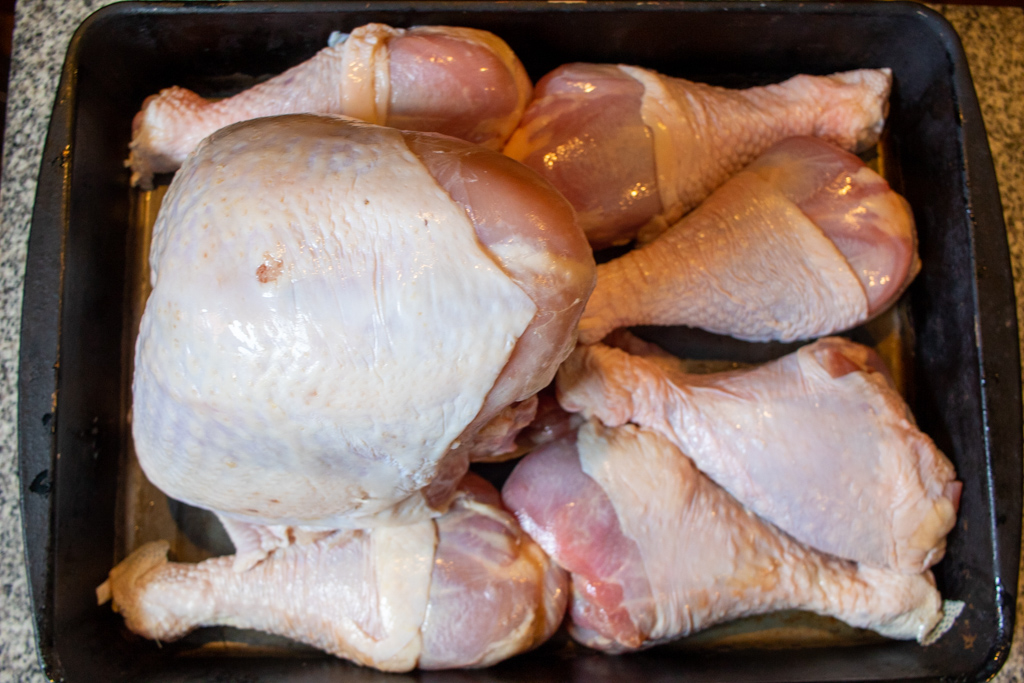
The recipe for Pavo Salvadoreño varies from household to household, from blog post to blog post, but the process remains fairly consistent between iterations: a wet roast, starting at a high temperature. Partway through the process, the turkey gets coated in a thick salsa, the temperature gets lowered, and the turkey roasts low and slow for the remainder of the cooking time, basted frequently. I managed to find an English language recipe that I liked for the pavo, but there are any number of recipes that would do.
As for bread, the sandwich in El Salvador calls for the local Pan Francés variant, an elongated roll much like a demibaguette or a Mexican bolillo. I tried my hand at making them–the bread was fine, but a little flat, without the high oven spring and light crumb I’d hoped for.

One nice thing about roasting a mutant six-legged turkey is that if different pieces are done at different times, they can be pulled one by one and foiled while the rest finishes. This makes for a juicy white meat and tender dark meat, counter to many people’s Thanksgiving experiences. In this particular instance, the legs finished about 15 minutes before the breast. Once pulled from the oven, my mutant six-legged turkey rested on a cookie sheet while I added a little corn starch to the stock-and-salsa mixture left in the roasting pan to thicken it.
More than once, I caught it looking at me, or so I imagined.
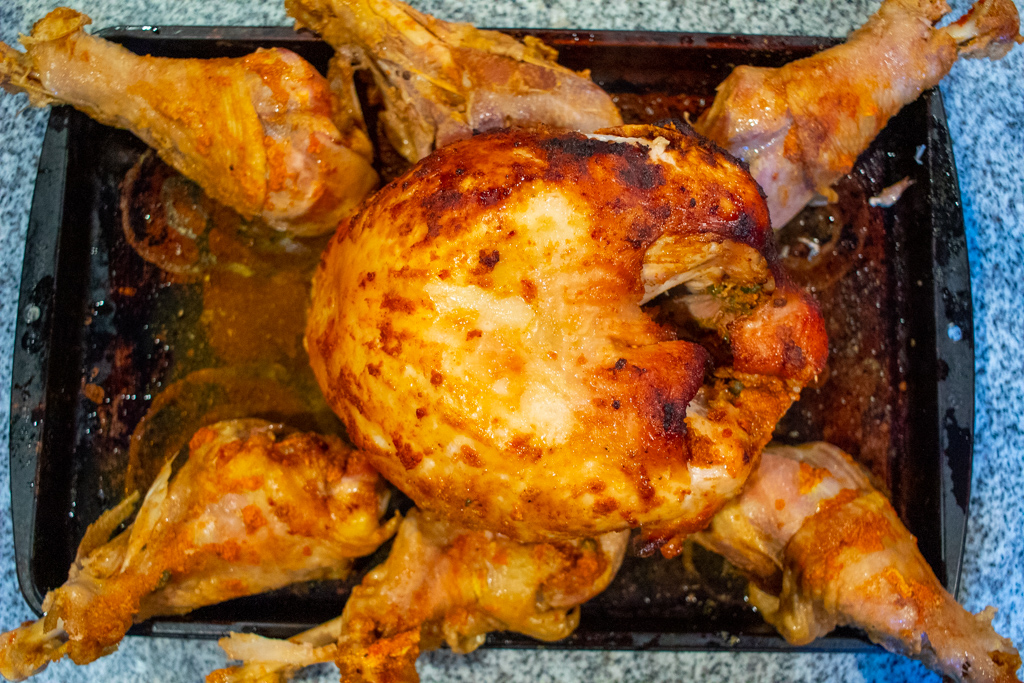
If anybody knows of a good way to carve the meat from a turkey leg, let me know, but I have not as yet succeeded with any method other than simply shredding the meat from the bone into a big bowl, with a fork, with a pair of kitchen shears, with my fingers, whatever is handy. The breast slices neatly at least, though each half is separated into two muscles with grains in different directions. In any case, meat was separated from bone and then returned to the roasting pan filled with the stock-and-salsa mixture.
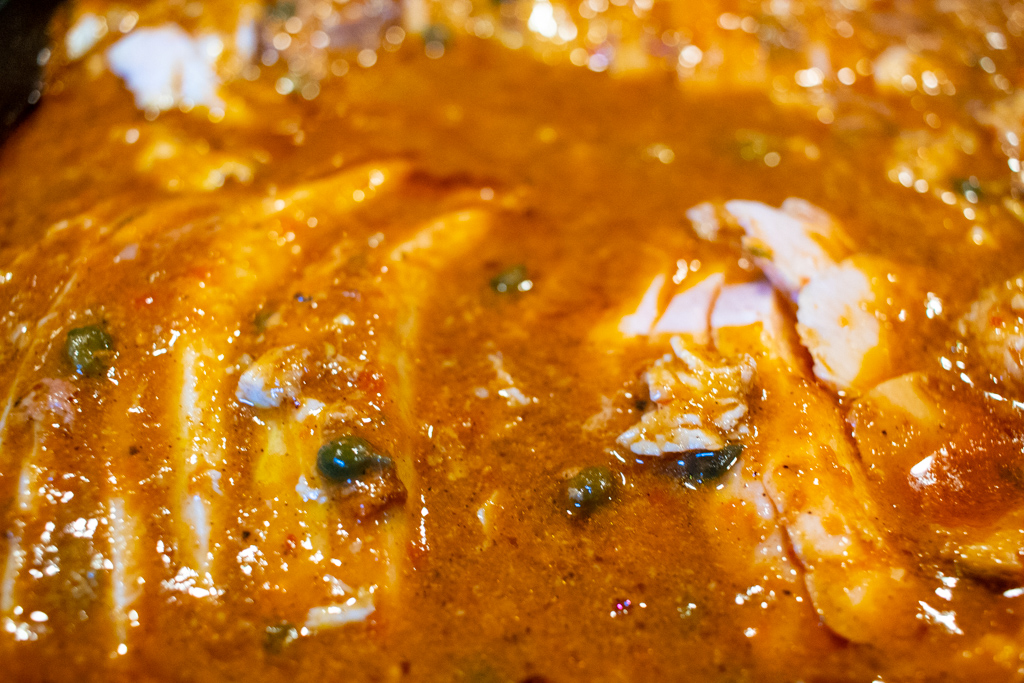
The remainder of the sandwich ingredients are variable, but will usually include at least tomato and cucumber, most likely some lettuce and/or smaller greens like watercress, thin slices of radish, and a vinegary cabbage quick pickle called curtido. It is very much like a coleslaw but tossed in vinegar without oil rather than a sweet creamy salad dressing.
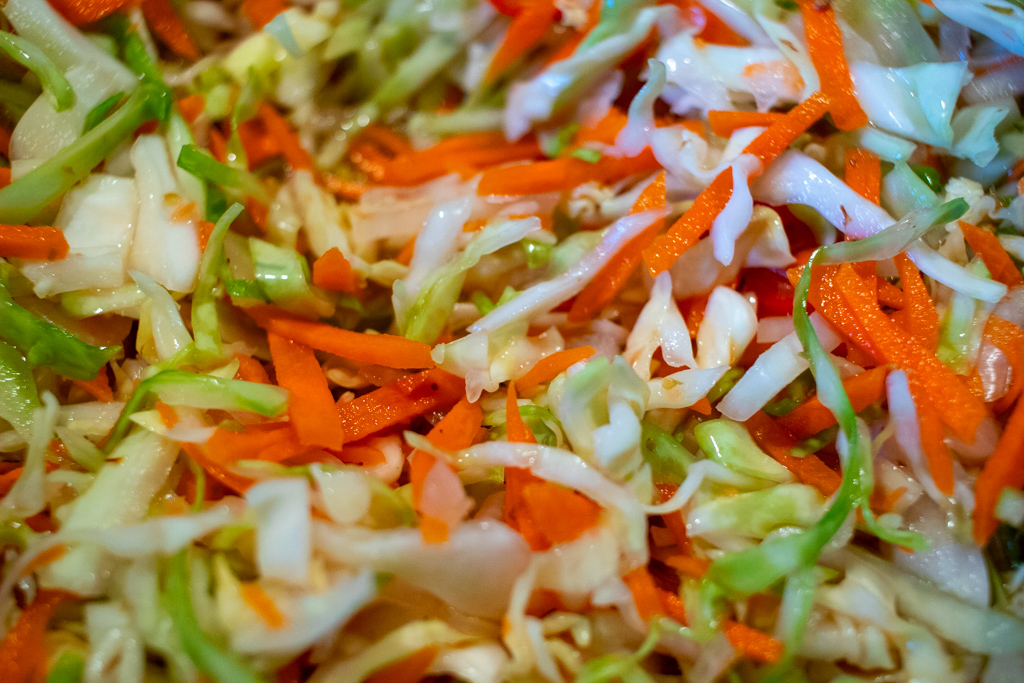
It looked like this sandwich would be of the overstuffed variety, so I’d hoped to leave something of a hinge on my pan francés. The oval shape of the roll and the relative density of the crumb didn’t really allow for it though.
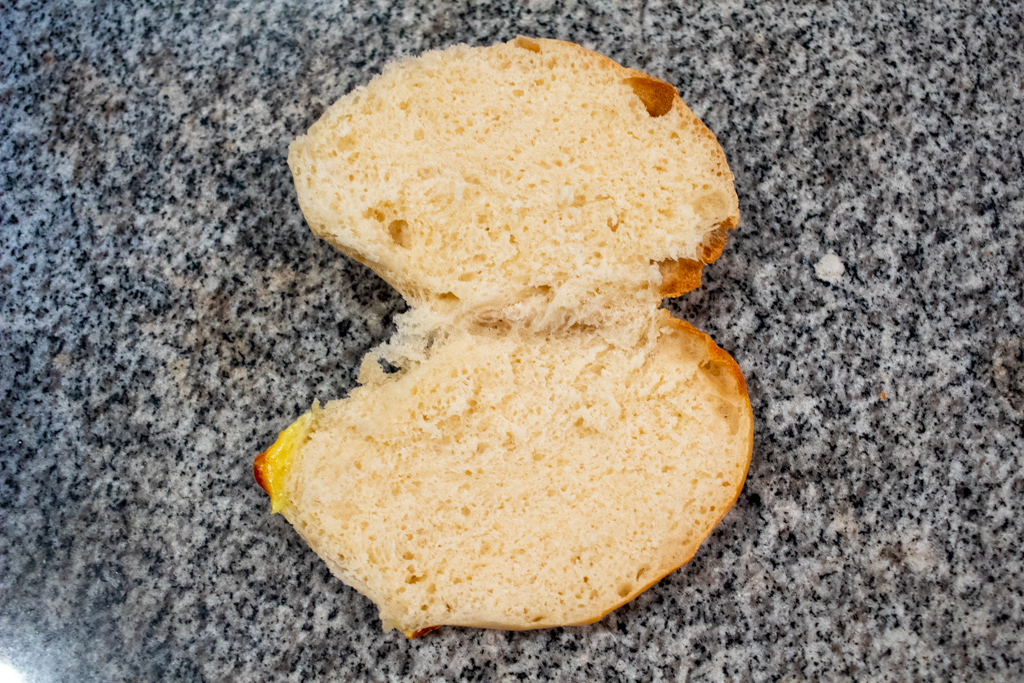
So I tried to use a large leaf of romaine lettuce in much the same way, as a kind of edible bib for the sandwich.
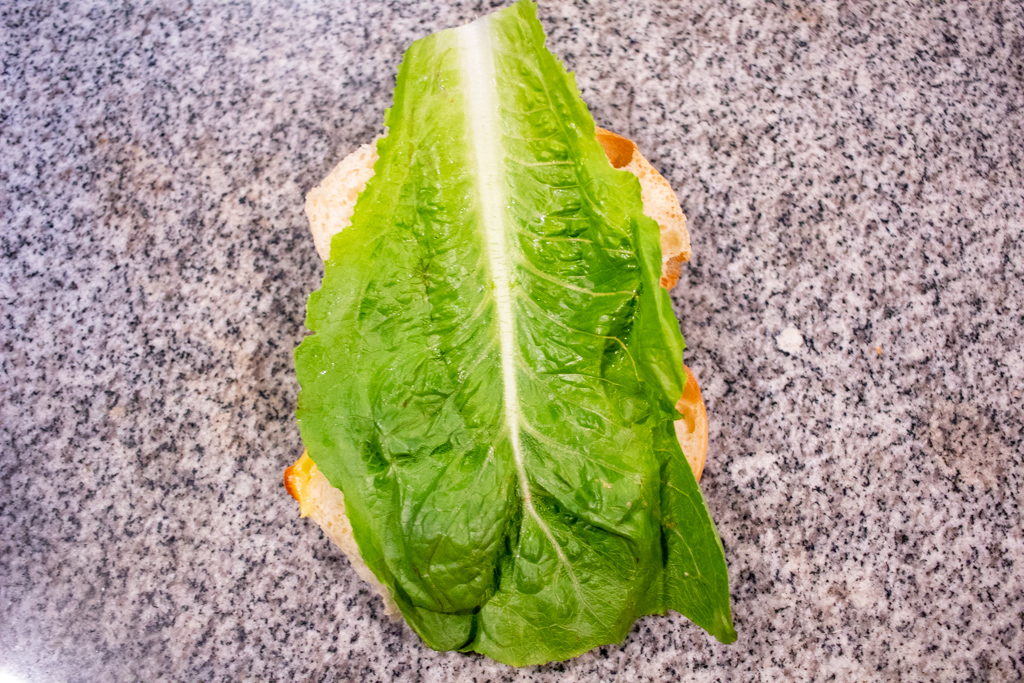
First I added a mixture of white and dark meat turkey, along with some of the pan sauce. Then sliced late-season tomato, freshly picked from my garden and as sweet as they come, with slices of cucumber and radish as well.
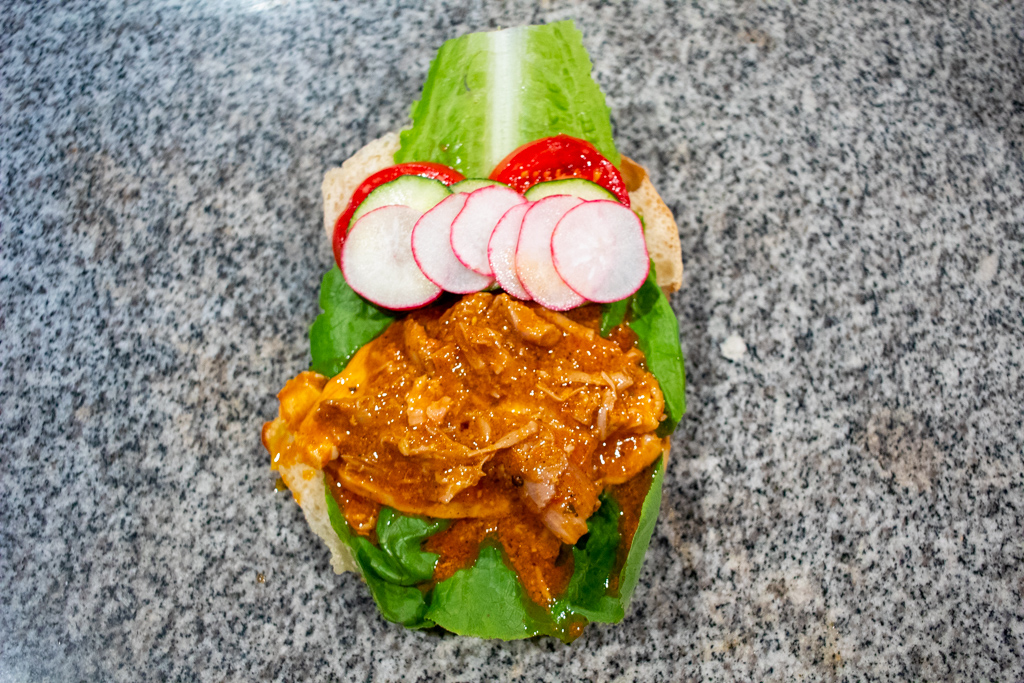
I put some of the curtido atop the meat, and some salad greens on top of that. Overkill, maybe, but I wanted to try a little bit of everything.
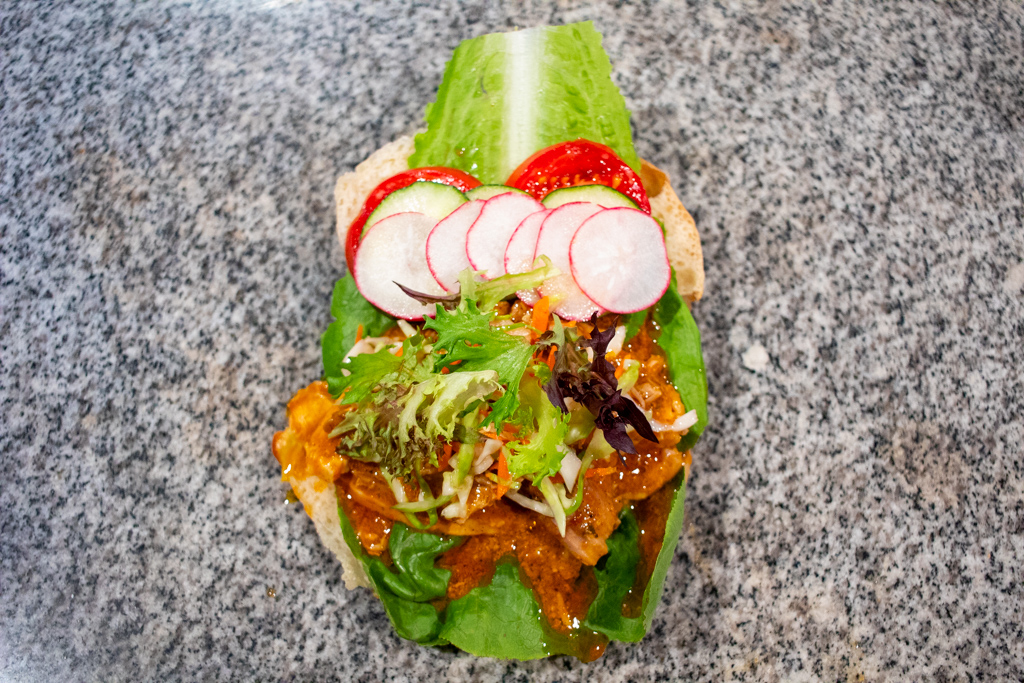
The sandwich was a mess, to be honest. But a delicious one!
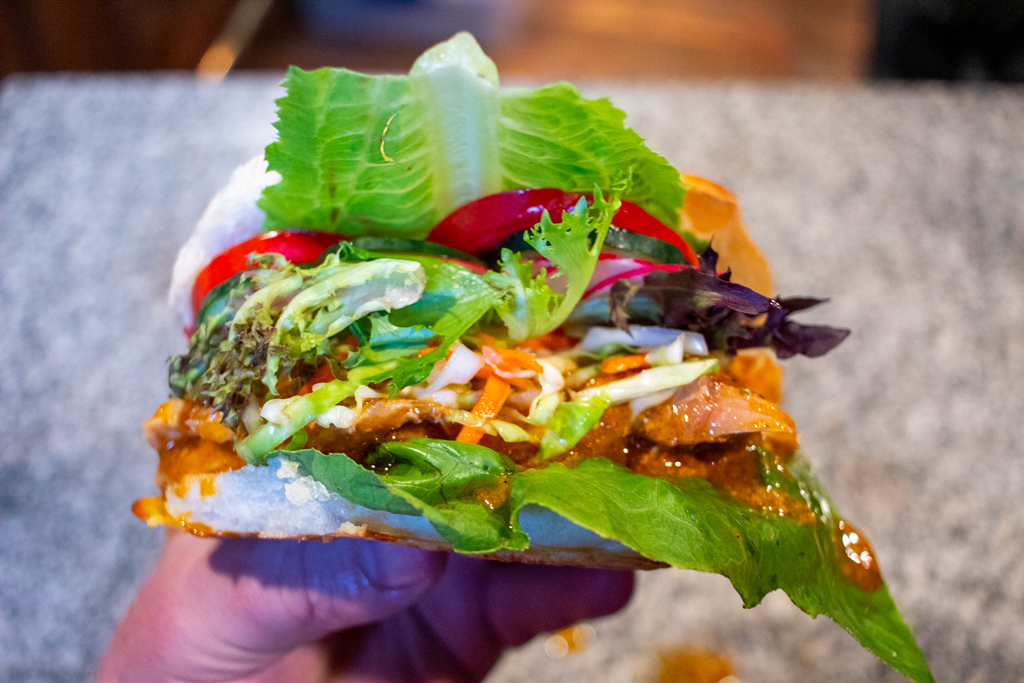
The main flavors, the turkey/sauce combination and the curtido, constituted a classic pairing of savory and acidic, the slight cider vinegar tang of the slaw cutting nicely through the stock-rich sauce with its nutty tomato/garlic/dried chili flavor. Domesticated turkey may have a mild flavor but it is distinctive, and that mixture of the tender and easily separated strands of breast muscle and tighter, more flavorful dark meat with the crunch of the vegetables gave the sandwich a mouth-pleasing variety of textures. If only I’d put it in better bread!
So I went out and bought some bolillo rolls instead from my local Mexican bakery and made the sandwich again.
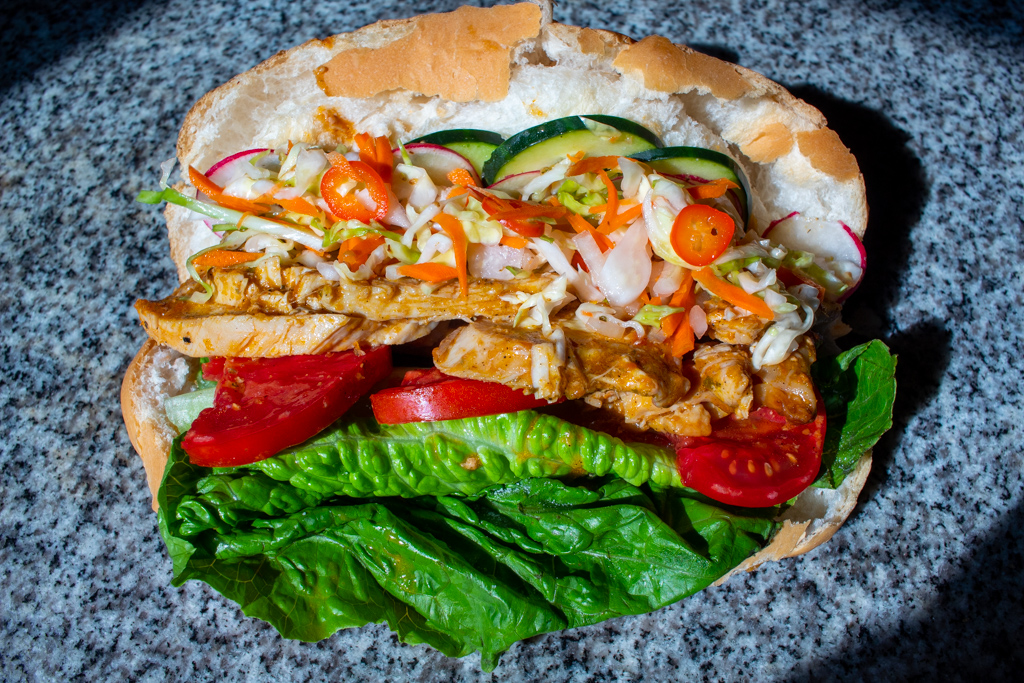
These bolillo rolls are fantastic for sub-type sandwiches, with an extremely light crumb that molds itself around ingredients, and a crust that firms up nicely with just a couple of minutes in the oven. I left out the smaller greens this time, placing romaine lettuce and tomato below the Pavo Salvadoreño and cucumber, radish, and curtido above it. Structurally, it was a much sounder sandwich.
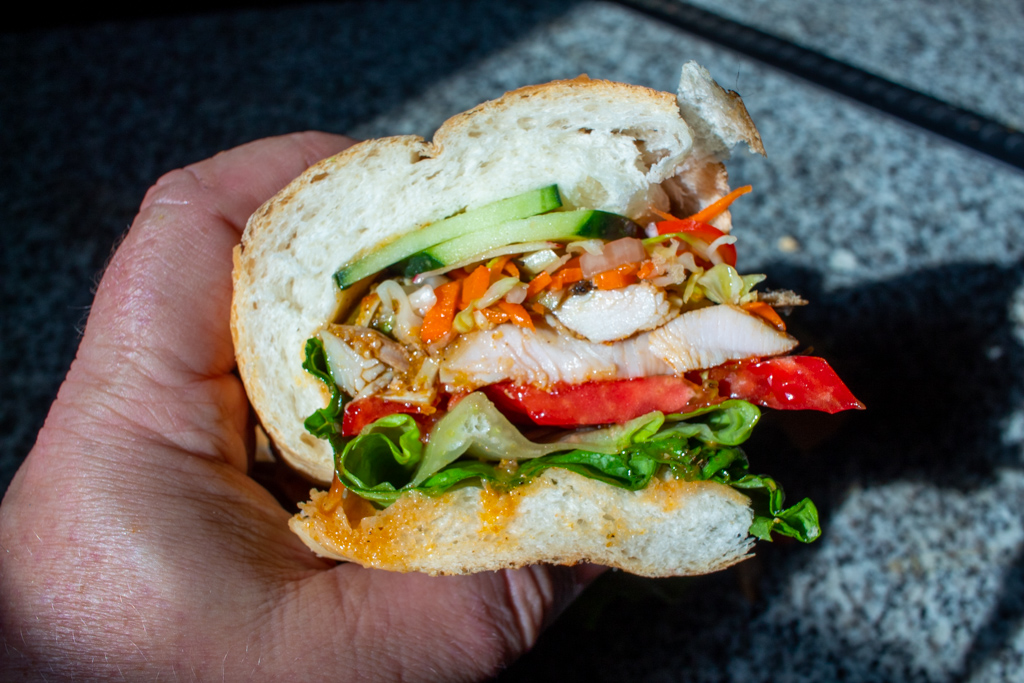
You might be tempted to add mayonnaise to this sandwich, and I won’t tell you not to, but it’s perfect as it is. The vegetables and the turkey’s sauce keep things moist enough to make mayonnaise redundant, and while the flavor might be detectable it is not necessary. This sandwich made me as happy as a sandwich has made me in a long time, a little spot of joy in a week marked mainly by employment’s ennui.
Pavo Salvadoreño is delicious, both on its own and as a basis for a sandwich. I don’t think it’ll change the way I cook turkeys going forward–I like cooking turkeys, I’m good at it, and the specificity of my turkey technique has everything to do with the the things I’ll be serving it with every November–the mashed potatoes and gravy, the yams, the cranberry sauce and stuffing, oh god the stuffing. For 10 months out of the year I can only dream about that stuffing.
I’d be lying though if I said I wasn’t considering saving some of this sauce and bringing it along with some bolillos to Thanksgiving dinner. I know you’re reading this, Mom. Make sure you have some radishes handy!

I like sandwiches.
I like a lot of other things too but sandwiches are pretty great


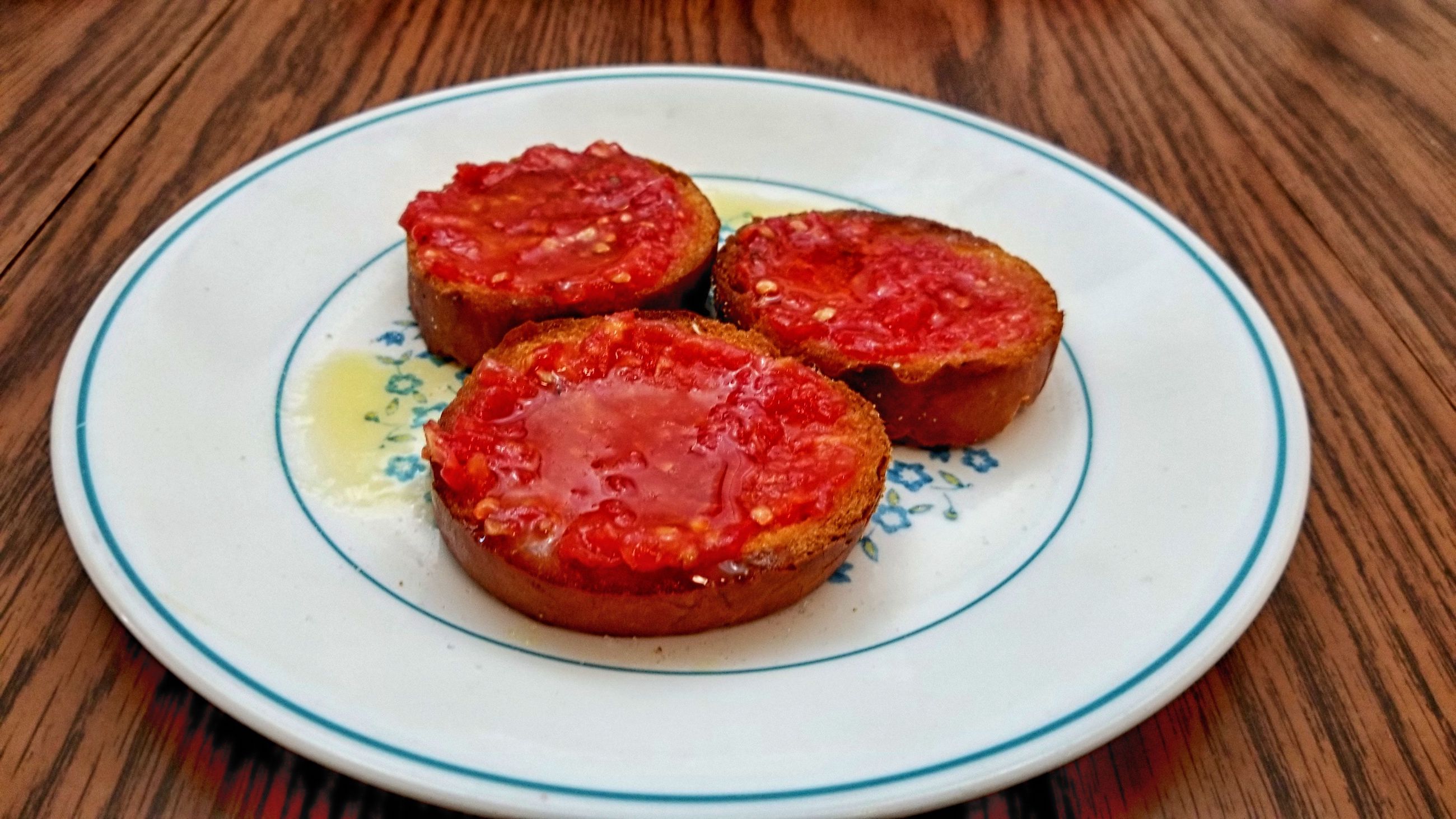

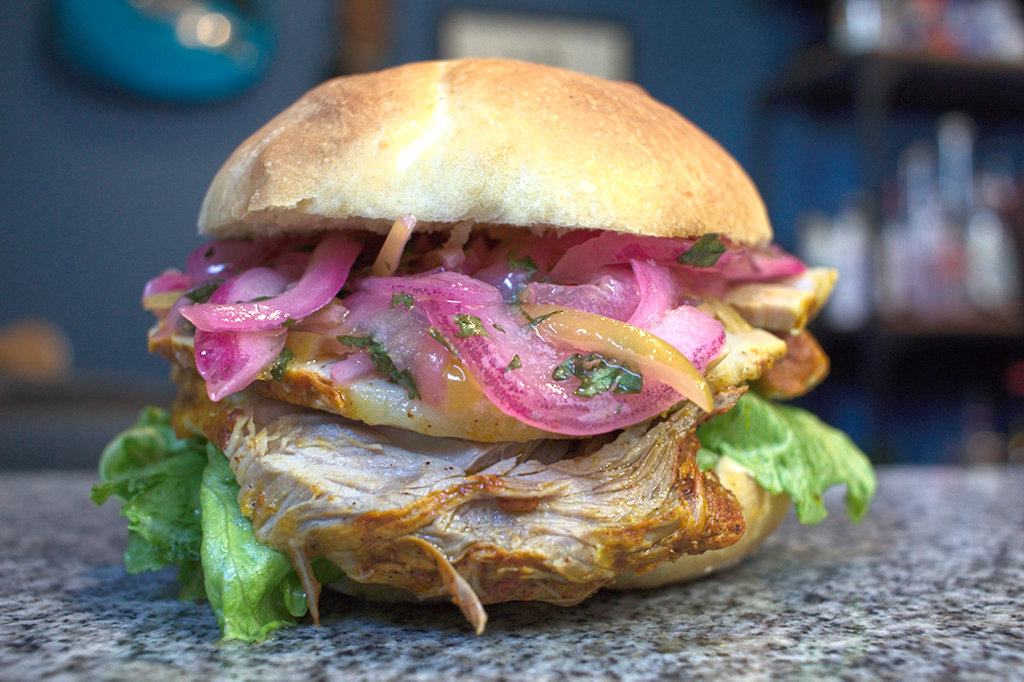






First of all, I am a huge fan of your site. I love how much I learn (about each sandwich and the history/surrounding culture). I’m consistently inspired by your kitchen skills and also impressed by your perseverance – you’ve tried some miserable sounding sandwiches (toast sandwich anyone? Not me!). I read this shortly before a trip to El Salvador and was inspired to make sure to eat a pan con pavo while there after reading this well-timed post. I went to a local chain (Pavito Criollo), so I may not have had the most authentic one, but it was quite good. Interestingly, the one I had came with a cup of the spicy sauce on the side (kind of like an au jus).
It had turkey (of course), lettuce, shredded carrot, pepper, and sliced onion. Maybe not the most traditional, but glad I tried it. I even took a picture for you (!), but don’t seem to see an option to post it with the comment, unfortunately.
Anyway – just dropping in to say thank you for all of the great posts and inspiration! I’m in New York City, but if I lived in Chicago, I’d for sure do my best to treat you to a few beers.
So glad you enjoyed panes con pavo! Just a note: chumpe means turkey. Not idiot. One of many words for turkey in Spanish. Pavo, chumpe, chompipe, guajolote and others. Salú!